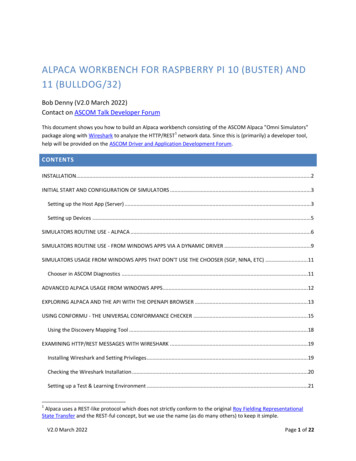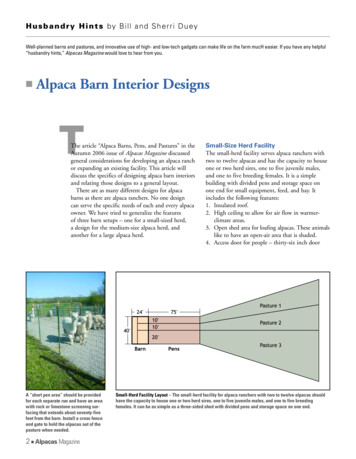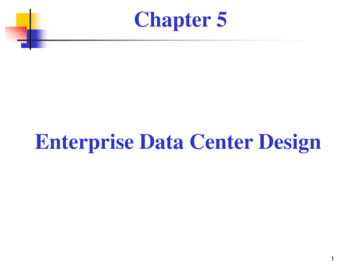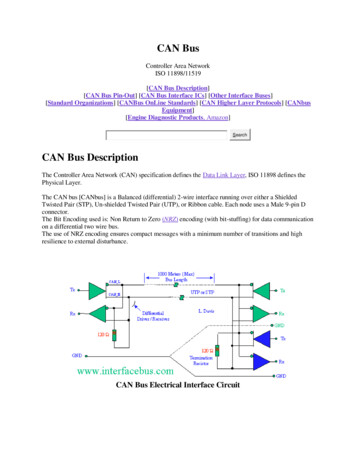
Transcription
ALPACA: Application Layer Protocol Confusion Analyzing and Mitigating Cracks in TLS AuthenticationMarcus Brinkmann1 , Christian Dresen2 , Robert Merget1 , Damian Poddebniak2 , Jens Müller1 , JurajSomorovsky3 , Jörg Schwenk1 , and Sebastian Schinzel21 Ruhr2 MünsterUniversity BochumUniversity of Applied Sciences3 Paderborn UniversityAbstractCross-Origin HTTPS RequestTLS is widely used to add confidentiality, authenticity andintegrity to application layer protocols such as HTTP, SMTP,IMAP, POP3, and FTP. However, TLS does not bind a TCPconnection to the intended application layer protocol. Thisallows a man-in-the-middle attacker to redirect TLS trafficto a different TLS service endpoint on another IP addressand/or port. For example, if subdomains share a wildcardcertificate, an attacker can redirect traffic from one subdomainto another, resulting in a valid TLS session. This breaksthe authentication of TLS and cross-protocol attacks may bepossible where the behavior of one service may compromisethe security of the other at the application layer.In this paper, we investigate cross-protocol attacks on TLSin general and conduct a systematic case study on web servers,redirecting HTTPS requests from a victim’s web browser toSMTP, IMAP, POP3, and FTP servers. We show that inrealistic scenarios, the attacker can extract session cookiesand other private user data or execute arbitrary JavaScript inthe context of the vulnerable web server, therefore bypassingTLS and web application security.We evaluate the real-world attack surface of web browsersand widely-deployed email and FTP servers in lab experiments and with internet-wide scans. We find that 1.4M webservers are generally vulnerable to cross-protocol attacks, i.e.,TLS application data confusion is possible. Of these, 114kweb servers can be attacked using an exploitable applicationserver. Finally, we discuss the effectiveness of TLS extensions such as Application Layer Protocol Negotiation (ALPN)and Server Name Indiciation (SNI) in mitigating these andother cross-protocol attacks.1Origin:www.attacker.com*.bank.comPOST /Host: www.bank.comCookie: secretHELP script reflect() /script www.bank.com:443*.bank.comCross-Protocol FTPS ResponseOption 2: Download AttackOrigin:www.bank.comftp.bank.com:990HTTP/1.1 200 OK script stored() /script Option 1:Upload AttackOption 3: Reflection AttackUnknown command: script reflect() /script Victim BrowserCookie: secretMitMApplication ServicesFigure 1: Basic idea behind application layer cross-protocolattacks on HTTPS. A MitM attacker leads the victim to anattacker-controlled website that triggers a cross-origin HTTPSrequest with a specially crafted FTP payload. The attackerthen redirects the request to an FTP server that has a certificatecompatible with the web server. The attack either (1) uploadsa secret cookie to FTP, or (2) downloads a stored maliciousJavaScript file from FTP, or (3) reflects malicious JavaScriptcontained in the request. In case (2) and (3), the JavaScriptcode is executed in the context of the targeted web service.client by presenting an X.509 certificate. In this setting, theserver is identified by the Common Name (CN) field or theSubject Alternate Name (SAN) extension in the certificate,which contains one or more hostnames or wildcard patterns(e.g., *.bank.com). As part of the certificate validation, theclient confirms that the destination of the request matches theCN or SAN of the certificate.Since TLS does not protect the integrity of the TCP connection itself (i.e., source IP & port, destination IP & port), aman-in-the-middle (MitM) attacker can redirect TLS trafficfor the intended TLS service endpoint and protocol to another,substitute TLS service endpoint and protocol. If the clientconsiders the certificate of the substitute server to be validfor the intended server, for example, if wildcard certificatesIntroductionTLS. With Transport Layer Security (TLS) [56], confidentialand authenticated channels are established between two communication endpoints. In typical end-user protocols, such asHTTP, SMTP, or IMAP, the TLS server authenticates to the1
are shared among subdomains, the authentication of the connection is violated. This can enable cross-protocol attacks atthe application layer, where the client unknowingly sends theprotocol data for the intended server to the substitute serverthat expects a different protocol, potentially compromisingthe security of either server at the application layer.In general, cross-protocol attacks can be considered between any two TLS-secured protocols. Although some protocol combinations will more likely lead to successful attacksthan others, even wildly different data formats can be interoperable. For instance, a length-specified binary protocolcan be embedded in HTTP [53]. The number of potentialattack scenarios exhibits quadratic growth with the numberof application protocols and implementations.with an email server or a content management system (e.g.,WordPress) colocated with an FTP server. Systematicallyextending the above attack example from [38], we considercross-protocol attacks on the web server that redirect crossorigin HTTP requests to SMTP, IMAP, POP3, or FTP servers,using one of three attack methods: 1. In an upload attack,the attacker tricks the victim into uploading secret sessiondata contained in the request (i.e., a cookie). 2. In a download attack, the attacker prepares a stored XSS payload at theapplication server and tricks the victim into downloading it.3. In a reflection attack, the attacker returns a cross-protocolresponse with a reflected XSS payload included in the request.In the two XSS methods, the script executes in the contextof the request and can be used to extract secrets or launchmalicious same-origin requests with the authority of the user,breaking the security of the web application.The protocols SMTP, IMAP, POP3, and FTP were selectedbecause they are line-based text protocols similar to HTTP,widely deployed on the Internet, likely to be configured withcertificates that are compatible with public web servers, andmature enough to minimize any potential risks to the infrastructure by our internet-wide scans.Attack variation. Under restrictive conditions, these attackscan even succeed in a pure web attacker model (MitB, but notMitM). For this, the application server must have the samehostname as the web server and the browser must not includethe port number in the Same-Origin-Policy (SOP). For themajority of this work, we assume a MitM MitB attacker andrevisit the pure MitB model in Section 8.Cross-Protocol Attacks on HTTPS. Cross-protocol attacks on unprotected HTTP were first described by JochenTopf [59], and we refer to Section 10 for the history of theseplaintext attacks. The first cross-protocol attack on a webserver secured by TLS was found by Jann Horn (with input from Michał Zalewski) [38], who demonstrates reflectedand stored Cross-Site-Scripting (XSS) attacks using an exploitable FTP server. Horn considered a MitM attacker whoalso has man-in-the-browser (MitB) privileges by serving aweb page with malicious JavaScript to the victim, as shownin Figure 1. This is the classical attacker model for attacks onthe TLS Record Layer, such as BEAST [19], CRIME [20],POODLE [45], and Lucky 13 [4]. Using the MitB, the attacker triggers an HTTPS POST request to the target webserver, where the body contains valid FTP commands. Usingthe MitM, the attacker redirects the request to an FTP serverwith a compatible certificate. The browser completes the TLShandshake with the FTP server and sends the HTTP requestas application data. If the FTP server is error-tolerant, it mayignore invalid data such as the HTTP header and execute thevalid FTP commands in the HTTP body. In this example,the payload is HELP script reflect() /script . Anexploitable FTP server reflects the embedded JavaScript tothe client in an error message. Although the response fromthe FTP server is not valid HTTP, an exploitable browser findsthe JavaScript by content sniffing [8] and executes it withinthe context of the original request, completing the attack [38].We note that during this attack, each component (browser,web server, and application server) functions as expected andthe security violation is an emergent property due to the attacker’s ability to recombine the components in an unintendedway. The root cause is the inability of the TLS authenticationmechanism to prevent the confusion in the first place.Evaluation. In practice, cross-protocol attacks are sensitiveto many requirements, such as certificate compatibility, abilityto upload, download, or reflect data, and application tolerancetowards syntax errors caused by mixing two protocols inone channel. In our case study of cross-protocol attacks onHTTPS, using SMTP, IMAP, POP3, and FTP applicationservers, we address these concerns in three evaluations.1. We identified 25 popular SMTP, IMAP, POP3, and FTPimplementations and evaluated their suitability for crossprotocol attacks on HTTPS in a series of lab experiments.We found that 13 are exploitable with at least one attackmethod (see Table 3). We also implemented a full proofof-concept that demonstrates all three attack methodson a well-secured web server, using exploitable SMTP,IMAP, POP3, and FTP application servers.2. We evaluated seven browsers for their error tolerance.We find that Internet Explorer and Edge Legacy stillperform content sniffing and thus are vulnerable to allpresented attacks, while all other browsers allow at leastFTP upload and download attacks (see Table 1).Systematic Analysis. In this work, we investigate crossprotocol attacks on TLS in general and on HTTPS in particular with a case study, where we target a web server forwhich the user may have established some kind of privilegedsession (i.e., the user is logged into an account). For example,this could be a webmail server (e.g., Roundcube) colocated3. In an internet-wide scan, we collected X.509 certificatesserved by SMTP, IMAP, POP3, and FTP servers. Weanalyzed how many of these are likely to be trusted by2
Server Certificates. In a typical TLS scenario on the web,a server authenticates to a TLS client with an X.509 certificate [14] during the handshake. The certificate contains theserver public key (which is used within the handshake), serverdomain name, expiration date, and several extensions. Forexample, there exist extensions for defining key usage (e.g.,signing and encipherment), extended key usage (e.g., WWWserver protection), and locating the certificate revocation list.For the security of the connection, it is crucial that the TLSclient validates all these certificate properties.major web browsers. For each certificate, we extractedthe hostnames in the CN field and SAN extension andchecked if there exists a web server on these hosts. Wefound 1.4M web servers that are compatible with at leastone trusted application server certificate, making themvulnerable to cross-protocol attacks (see Table 4). Ofthese, 119k web servers are compatible with an application server that is exploitable in our lab settings.Countermeasures. We present generic countermeasures toall cross-protocol attacks, based on the ALPN and SNI extensions. These countermeasures solve the issue at the TLS layerand can be deployed without backward compatibility issues.Server Name Indication (SNI). In some deployments, several web (or other) services may be hosted at the same IPaddress and port. To support this virtual hosting configuration, the client indicates the desired hostname in the ServerName Indication (SNI) extension [22]. While SNI is wellsupported by HTTPS servers, it is much less common in otherapplication protocols such as SMTP, IMAP, POP3, and FTP.Contributions. We make the following contributions: The first generic description of cross-protocol attacksagainst TLS applications.Application-Layer Protocol Negotiation (ALPN). TheALPN extension [27] allows the TLS peers to select a specificapplication layer protocol. With ALPN, a web server canoffer different application layer protocols on the same port,for example, more performant versions of the HTTP protocol(in particular, HTTP/2 along with HTTP/1.1), while avoidingadditional round trips for protocol negotiation. The clientsends the protocols it supports as a list of strings to the server,and the server selects a protocol it supports or sends an alertif no protocol supported by the server is found among thelist. Protocol names are presented in ASCII and assigned byIANA.1 The names for HTTP, IMAP, POP3, and FTP havealready been standardized, while SMTP is not yet registered. A systematic case study of cross-protocol attacks againstHTTPS, exploiting popular SMTP, IMAP, POP3, andFTP application servers. A complete IPv4 scan for web and application serversallowing such cross-protocol attacks, measuring the number of vulnerable and exploitable services. Analysis of generic countermeasures to cross-protocoland related content confusion attacks with minimalchanges to implementations and standards.Responsible Disclosure and Artifact Availability. We reported our findings to TLS libraries, exploitable applicationservers, and our national CERT. We will publish all sourcecode used in the evaluation of this paper as Open Source pplication Layer ProtocolsHTTP. The Hypertext Transfer Protocol (HTTP) [24] is aline-based text protocol for the World Wide Web, which istypically accessed with a browser. Web servers are securedby TLS and other safeguards to protect sensitive user data.For example, cookie attributes (e.g., Secure, HttpOnly, orSameSite) protect authentication tokens, Content SecurityPolicy (CSP) protects against cross-site scripting attacks, andthe Same Origin Policy (SOP) mitigates cross-domain interaction risks, while Cross-Origin Resource Sharing (CORS)enables sharing across domains in a controlled manner.BackgroundTLS and X.509 CertificatesTransport Layer Security (TLS) is a cryptographic layer between the transport layer (i.e., TCP) and an application layerprotocol [17]. The TLS protocol consists of two phases. In thefirst phase, the client and server perform a TLS handshake toexchange used versions, randoms, cryptographic algorithms,and supported extensions, in order to derive symmetric keys.In the second phase, the symmetric keys are used to protectapplication data, such as HTTP, SMTP, IMAP, POP3, or FTP.Email Protocols and FTP. The Simple Mail Transfer Protocol (SMTP) [40] is used to send emails. Post Office Protocol (POP3) [47] and Internet Message Access Protocol(IMAP) [15] are used to access them. The File Transfer Protocol (FTP) is a protocol to upload and download arbitrary filesto a server [52]. All protocols are line-based text protocols.TLS can be used either explicitly by upgrading an insecureSTARTTLS. Unprotected legacy protocols can be extendedto support TLS by upgrading a plaintext connection usinga protocol-specific STARTTLS command. After the TLShandshake succeeds, the legacy protocol is continued in theencrypted application data. STARTTLS was first standardizedin RFC 2487 [35] as an extension to SMTP.1 -values/tls-extensiontype-values.xhtml3
connection using the STARTTLS (or similar) command orimplicitly by connecting on an alternative port. A peculiarityof the SMTP protocol is that after sending a command, theclient should wait for the server’s response before sending thenext one unless the server supports command pipelining [26].Note that FTP uses separate connections for control anddata transfer. The client first opens a control connection, thensends a command to open a data port in the server. Then itestablishes an implicit TLS connection to that port to uploador download files (aka passive mode). We assume the FTPserver enforces TLS session resumption on the data connection to protect against well-known port stealing attacks [5]by binding the data channel cryptographically to the controlchannel, as first proposed and implemented by Chris Evansand Tim Kosse [23].3instead of Sint . In this case we say that Sint and Ssub are vulnerable to cross-protocol attacks. This loss of authenticationcan lead to severe security issues at the application layer andpotentially a loss in confidentiality, for example if Ssub writesapplication data to a log file readable by the attacker.In practice, cross-protocol attacks are hindered by a seriesof obstacles. We identify the following requirements forcross-protocol attacks to be exploitable: TLS Compatibility. The client C and application serverSsub must complete the TLS handshake, and C mustaccept the certificate of the substitute server as valid forthe intended server. We provide more details on thisrequirement in Subsection 3.1. Tolerance To Protocol Embedding. Ssub should tolerate acertain amount of invalid traffic that comes from protocolA in which the payload for Ssub in format B is embedded. Likewise, if the client is expected to process anyresponse by Ssub , it should tolerate a certain amount ofinvalid traffic that comes from protocol B in which thepayload for C in format A is embedded.TLS-Based Cross-Protocol AttacksIn a generic cross-protocol attack, we assume a client C andtwo application servers Sint and Ssub . The client C uses protocol A with the intended server Sint . The substitute serverSsub uses an unrelated protocol B and runs on a different TCPendpoint (IP, port). However, Ssub has a certificate that is compatible with Sint , i.e., the certificate could be used by Sint inplace of its regular certificate without breaking the intendedconnection from the client. The goal of the attacker is totrick either Ssub into accepting application data from C or totrick C into accepting application data from Ssub . Because Cand Ssub use different protocols, this type of attack is called across-protocol attack. The attack works like this: Application Server Exploitability. Ssub must providesome feature, mechanism, or behavior supporting theattack. The details are protocol- and implementationspecific, but generally, the exploited behavior will beunexpected by C and differ considerably from the behavior of Sint , resulting in some form of security violation.3.1TLS Compatibility1. The man-in-the-middle (MitM) attacker interposes theTCP connection between C and Sint , and forwards alldata from C to Ssub and vice versa. Optionally, the MitMfirst creates a new TLS endpoint on Ssub with STARTTLS and only then forwards the TLS traffic from C.To enable cross-protocol attacks, the server Ssub must providea certificate and TLS configuration that is compatible with thecertificate and configuration of Sint such that C will successfully complete a handshake with Ssub in a MitM scenario. Wewill now describe the most important requirements for this.2. The application server Ssub performs the TLS handshakewith the client C and presents its certificate Certsub .Certificate Names. The client application must accept theserver names in the certificate of Ssub as valid for Sint . Thiscan be the case for one of two reasons: 1. The certificate presented by Ssub has the hostname of Sint in the CN field or SANextension, or 2. The certificate of Ssub is a wildcard certificatethat matches the hostname of Sint (e.g., *.bank.com matcheswww.bank.com). Such configurations occur spontaneouslywhen an administrator, unaware of the risk of cross-protocolattacks, deploys a multi-domain or wildcard certificate tosave costs and administrative effort, or simply copies a webserver certificate to another application server to support opportunistic encryption without validation, as is common fornon-HTTPS services [36]. Note that for the success of crossprotocol attacks it is not required that the certificate presentedby Ssub is valid for Ssub itself.3. Because Certsub is compatible with Sint , the client C accepts it and completes the TLS handshake. Subsequently,C will send application data to Ssub .4. Ssub tries to interpret the data sent by C. Because theclient sends application data in format A and the Ssubexpects format B, this may result in security violations.5. If Ssub responds by sending, e.g., error messages to C informat B, the client processes these as if they were informat A, which may also result in security violations.The presented attack breaks the authentication of the connection in Step 3, when C finishes the handshake with Ssub , asC is not noticing that it performed the handshake with SsubCertificate Validity. The certificate must also satisfy a broadrange of other conditions to be considered valid by C. Most4
importantly, the certificate must be signed by a certificateauthority trusted by C, and the certificate must not be expired.Note that there is no possibility to define the designatedapplication layer protocol in an X.509 certificate. While acertificate can include an extended key usage extension, thisextension can only indicate a very broad purpose for whichthe certified public key may be used [14], for example, codesigning, client/server authentication, or email protection.As is common for TLS attacks [4, 19, 20, 45], we considera more powerful MitM attacker, who is also a man-in-thebrowser (MitB) with the ability to execute arbitrary JavaScriptin the context of a website controlled by the attacker. TheMitB attacker can force the client to send cross-origin requeststo the targeted web server but is unable to read the responsedue to the Same-Origin-Policy (SOP). However, the attackercan control some parts of the HTTP header, and, in the caseof the POST method, the complete body of the request. In asimple cross-protocol scenario, the attacker accepts the headers as given and places a malicious payload in the body. If thesubstitute server tolerates the HTTP header, it will eventuallyreach the body of the request and process the malicious payload, giving the attacker full access to the features providedby the substitute server protocol and implementation.TLS Handshake Parameters. The TLS protocol itself canalso cause the attack to fail. In particular, the client C mustsupport at least one TLS version and cipher suite offered bySsub which may differ from those provided by Sint . This isespecially important if the two protocols adopt new versions,cipher suites, and extensions at different speeds, for exampleif the client C deprecates some features before Ssub is updatedto support suitable replacements.ALPN. If the client C supports the ALPN extension, it willsend only the ALPN identifiers for the intended protocols.If Ssub is also implementing the ALPN extension, it cannotchoose a matching application layer protocol. In this case, theALPN extension mandates to abort the handshake and send afatal TLS alert message [27]. Thus, at first glance, this mightprevent the attack. However, ALPN was never considered asa security feature, but merely as a mechanism to multiplexdifferent protocols on the same TCP endpoint [27]. If thesubstitute server is unaware of ALPN, or the ALPN extensionis not transmitted by C, or a failure in ALPN negotiation issilently ignored by the server, the handshake proceeds despiteALPN. We will show in Subsection 7.2 that this is often thecase for servers implementing protocols other than HTTPS.4.1Through an extensive review of the existing documentationof browser-related cross-protocol attacks, we identified threegeneral methods the attacker can use within application layerprotocols to attack HTTPS sessions.Upload Attack. For this attack, we assume the attacker hassome ability to upload data to Ssub and retrieve it later. In anupload attack, the attacker tries to store parts of the HTTPrequest of the browser (specifically the Cookie header) onSsub . This might, for example, occur if the server interpretsthe request as a file upload or if the server is logging incoming requests verbosely. After a successful attack, the attackerretrieves the content on the server independently of the connection from C and retrieves the HTTPS session cookie.SNI. A client may specify the server name in the SNI extension. If Ssub is not responsible for resources on the indicatedserver name, it can reject the connection and thus preventthe attack. However, cross-protocol attacks are not affectedby SNI if two services run under the same name, or if thesubstituted server does not implement it, or if the server ismisconfigured. Similar to ALPN, SNI was not specified asa security feature, but to multiplex different virtual servers(possibly implementing the same protocol) on the same TCPendpoint. It is still not widely supported outside of HTTP.We will show in Subsection 7.2 that servers implementingprotocols other than HTTP often ignore the SNI extension.4Attack MethodsDownload Attack – Stored XSS. For this attack, we assumethe attacker has some ability to store data on Ssub and download it. In a download attack, the attacker exploits benignprotocol features to download previously stored (and specifically crafted) data from Ssub to C. This is similar to a storedXSS vulnerability. However, because a protocol differentfrom HTTP is used, even sophisticated defense mechanismsagainst XSS, like the Content-Security-Policy (CSP) [64], canbe circumvented. Very likely, Ssub will not send any CSP byitself, and large parts of the response are under the control ofthe attacker.Cross-Protocol Attacks on HTTPSReflection Attack – Reflected XSS. In a reflection attack,the attacker tries to trick the server Ssub into reflecting partsof C’s request in its response to C. If successful, the attackersends malicious JavaScript within the request that gets reflected by Ssub . The client will then parse the answer from theserver, which in turn can lead to the execution of JavaScriptin the context of the targeted web server.We now consider only cross-protocol attacks where the clientC is a web browser using HTTPS. The goal of the attacker iseither to execute JavaScript in the context of the targeted webserver, leading to Cross-Site-Scripting (XSS), or to steal thesession cookie of an already logged in user. After describingour attacker model, we will discuss specific requirements forsuch cross-protocol attacks against HTTPS.5
4.2Web Browser ToleranceWith reflection and download attacks, the data returned bySsub will often not be a proper HTTP response but contain‘noise’ in the form of a banner identifying the applicationserver, as well as any syntax errors and other messages outputby the server processing the HTTP request. This is particularly significant for the very beginning of the response, wherethe web browser expects an HTTP response status line. Ifthis line is missing, a browser may assume HTTP/0.9, whichallows a Simple-Response [10, ch. 4.1] that does not containany headers. Without headers specifying the content type, theembedded JavaScript will only be executed if the the browserinterprets the response as HTML due to content-sniffing [8].4.3ResultsHeader LinesContent SniffingKeep-Alivew/ HTTP/1.1w/ noisecyegaLera arigegeEd Ed Op Saf17#11#111217#17#11########Support# No supportTable 1: Browser behavior relevant to cross-protocol attacks.makes some cross-protocol attacks using only a single HTTPrequest very challenging.If the attacker is able to force several HTTP requests withina single connection, more sophisticated cross-protocol attacksmay become practical. Using multiple requests allows theattacker to send a malicious payload to Ssub in the first requestto prepare Ssub into a state that allows the second request tocomplete the attack. This strategy is especially useful forupload attacks, where the first request prepares Ssub in sucha way that the cookie in the second request is uploaded tothe server. However, in order to send two HTTP requestsinside a single TLS connection, the browser has to reuse theconnection. We evaluate when this is the case in Section 5.Even more powerful attacks are possible if Ssub is vulnerable to a TLS renegotiation attack [55], which allows anattacker to prepend arbitrary bytes to the victim plaintext data,bypassing all potential protocol countermeasures and intolerances. This way, application data of the client gets interpretedin the attacker session such that the attacker can prepare anarbitrary prefix for transmitted application data.Application Server Error ToleranceSending an HTTP request to a non-HTTP server will likelycause syntax errors due to differences in the protocol languages. Thus, it is an advantage for the attacker if Ssub is“liberal” in what it accepts in the sense of Postel’s Law.2An HTTP request consists of four parts: 1. The HTTP request line with method, URI, and version, 2. zero or morekey: value header fields, 3. an empty line separating theheader from the body, and 4. the attacker-controlled body ofthe request containing the POST data. For a successful attack,we require that the application server keeps processing commands even after encountering the initial HTTP request lineand up to a certain number of HTTP header lines. Some application servers terminate the connection after some numberof syntax errors. If this number is too low (i.e., smaller thanor equal to the number of lines in the header), our attack willprobably fail because the POST data in the request will neverbe processed. The exact number of header lines that must beprocessed without terminating the connection depends on theweb browser of the victim. For example, Chrome 83 sends 17header lines as part of a POST request (see Table 1).Additionally, some application servers (e.g., Postfix SMTP)specifically try to detect cross-protocol attacks by recognizingcommon HTTP method tokens in the request line.4.4exrom irefo EhCFI5Evaluation of Web BrowsersWe evaluated the browser behavior relevant to cross-protocolattacks for Chrome 86, Firefox 81, Internet Explorer 11, EdgeLegacy 44, Edge 86, Opera 71, and Safari 14 by manuallyaccess
ALPACA: Application Layer Protocol Confusion - Analyzing and Mitigating Cracks in TLS Authentication Marcus Brinkmann1, Christian Dresen2, Robert Merget1, Damian Poddebniak2, Jens Müller1, Juraj Somorovsky3, Jörg Schwenk1, and Sebastian Schinzel2 1Ruhr University Bochum 2Münster University of Applied Sciences 3Paderborn University Abstract TLS is widely used to add confidentiality .










